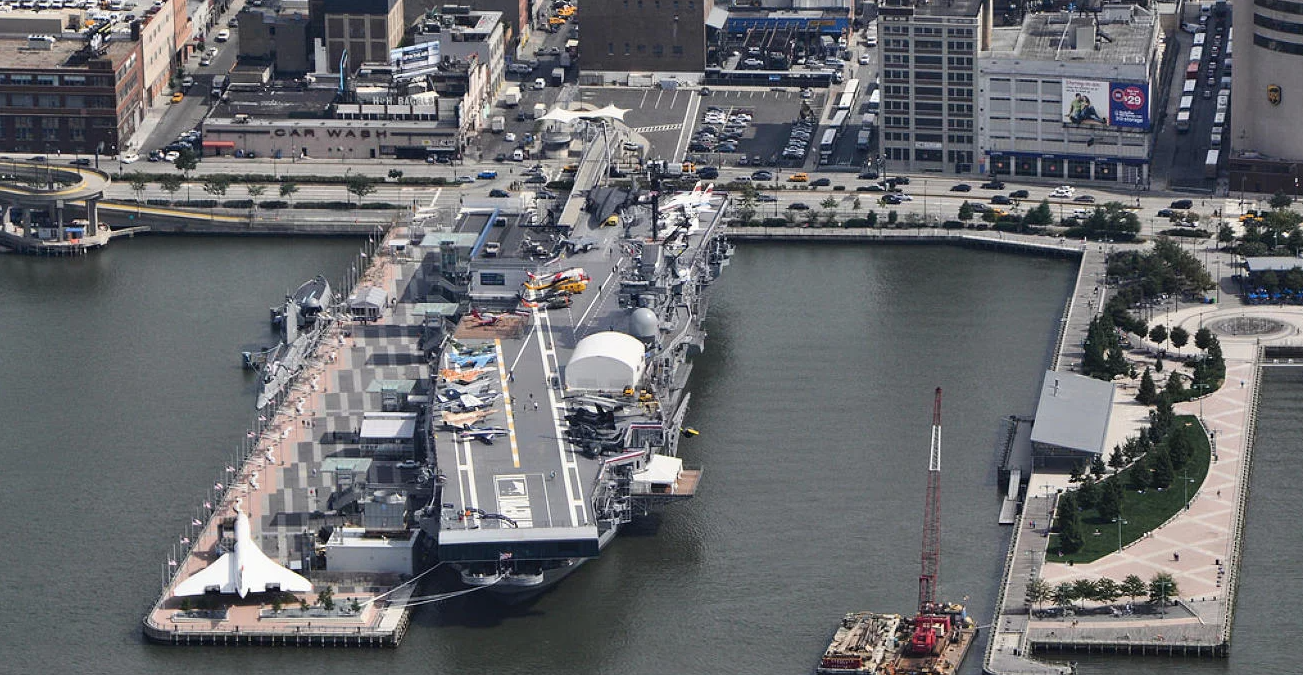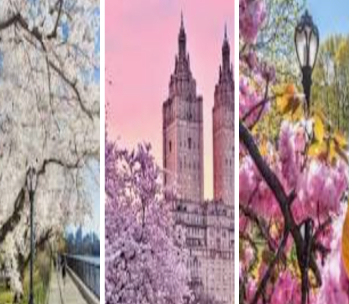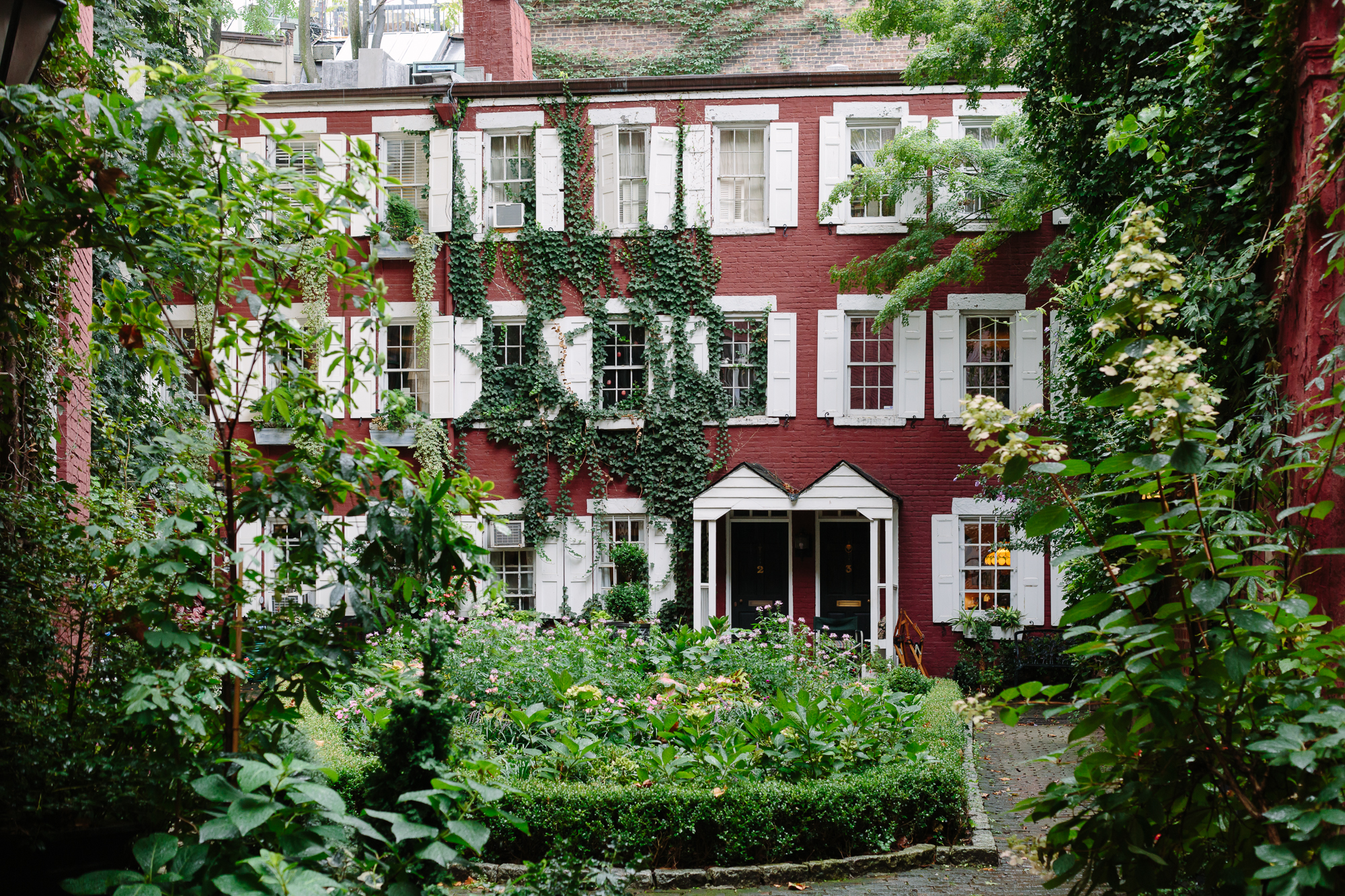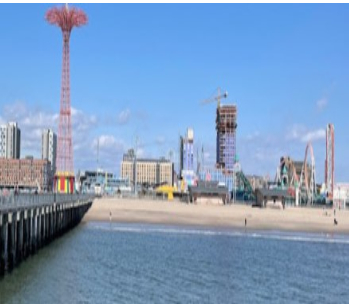Top Tourist Attractions in New York City
New York City, the biggest and most populated city in the USA, is known as the "city that never sleeps" because it's always lively. It's filled with arts, culture, countless restaurants, and bright skyscrapers lighting up the night sky, making it a magical place. Manhattan, in particular, is loud, energetic, and always bustling with activity.
For those new to New York, the city can be overwhelming. This list covers the top tourist attractions in New York City that you won't find anywhere else. From Broadway to the One World Trade Center, we've included them all.
Statue of Liberty

The Statue of Liberty is a famous and treasured landmark, known around the world. Every year, millions of people visit to see her and learn about her history. She represents freedom, inspiration, and hope.
In the late 1800s, a major female symbol in American culture was the Roman goddess Libertas, a woman dressed in robes. In ancient Rome, she was honored as the goddess of freedom, especially by slaves.
The Statue of Liberty, a gift from France to the United States, has greeted new arrivals to America for over a hundred years. Standing 93 meters (305 feet) tall, visitors can climb to see views of Brooklyn and the supportive framework by Gustave Eiffel.
For those who don't want to climb the 154 steps to the crown, the pedestal offers panoramic views of the harbor and downtown New York City. Park Rangers provide guided tours of Liberty Island throughout the day, and a self-guided audio tour in nine languages is included with a ferry ticket to the island.
Times Square
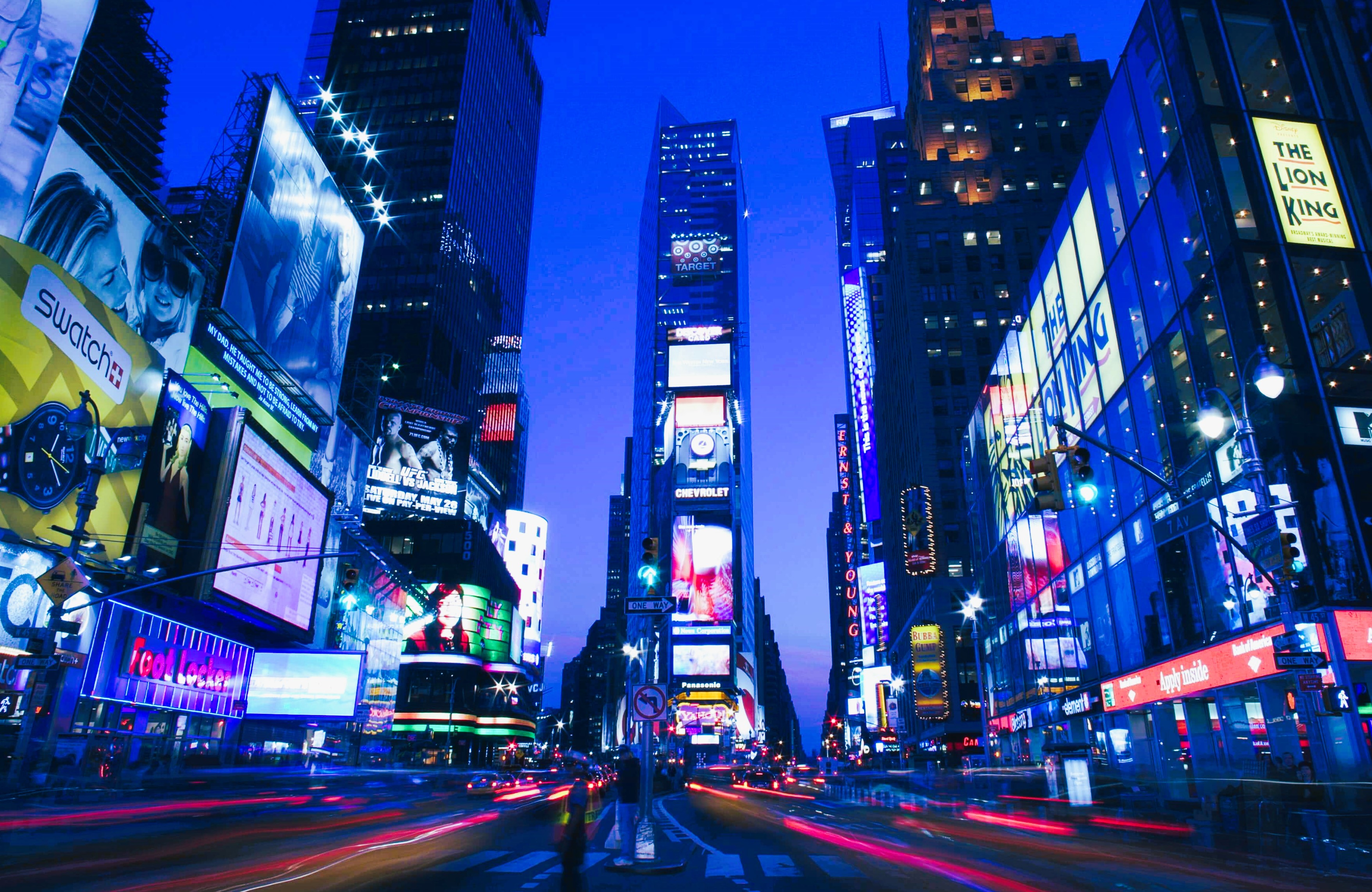
Times Square, often referred to as "The Crossroads of the World," is one of the most iconic and bustling areas in New York City, USA. Located in the heart of Midtown Manhattan at the junction of Broadway and Seventh Avenue, it extends from West 42nd to West 47th Streets. Known for its bright, towering electronic billboards and bustling atmosphere, Times Square is a major commercial and entertainment hub.
Times Square was originally called Longacre Square but was renamed in 1904 after The New York Times moved its headquarters to the newly constructed Times Building, which is now known as One Times Square. This building is famously the site of the annual New Year's Eve ball drop, a tradition that began in 1907 and draws millions of spectators each year.
Entertainment and Nightlife
Theaters and Cinemas: In addition to Broadway theatres, Times Square hosts a variety of off-Broadway theatres and cinemas, including the AMC Empire 25, one of the largest movie theaters in the United States.
Comedy Clubs and Music Venues: The area is home to famous comedy clubs like Carolines on Broadway and live music venues where visitors can enjoy a wide range of performances.
Dining
Restaurants and Eateries: Times Square offers a diverse array of dining options, from high-end restaurants to fast-food chains and street vendors. Notable spots include the Hard Rock Café, Bubba Gump Shrimp Co., and the famous Junior's Restaurant known for its cheesecake.
Themed Restaurants: Many themed restaurants are popular tourist attractions, such as Planet Hollywood and the Marvel Avengers S.T.A.T.I.O.N.
Shopping
Flagship Stores: Times Square features flagship stores of major brands like Disney, M&M’s World, and Hershey's Chocolate World, offering unique shopping experiences.
Souvenir Shops: Numerous souvenir shops cater to tourists, offering everything from postcards to I ❤️ NY merchandise.
Public Spaces and Art Installations
Pedestrian Plazas: The redesign of Times Square included the creation of pedestrian-only areas with seating, making it a more pedestrian-friendly space where people can relax and soak in the atmosphere.
Public Art: Times Square frequently hosts public art installations, such as the Midnight Moment, the world's largest and longest-running digital art exhibition synchronized on electronic billboards throughout the square.
Media and Technology
News and Media Headquarters: In addition to The New York Times' historical presence, Times Square houses major news networks like ABC's Times Square Studios, from where "Good Morning America" is broadcast.
Technological Innovations: The area is a hotspot for technological displays and innovations, often showcasing cutting-edge digital advertising technologies.
Transportation Hub
Subway Station: Times Square-42nd Street/Port Authority Bus Terminal is one of the busiest subway stations in New York City, providing access to multiple subway lines and facilitating easy transportation across the city.
Accessibility: The area is also close to major transportation hubs like Penn Station and Grand Central Terminal, enhancing its connectivity.
Safety and Security
NYPD Presence: Times Square is known for its significant police presence, which ensures safety for the millions of visitors and workers in the area. The NYPD has a dedicated Times Square unit.
Pedestrian Safety Initiatives: Various measures, including the pedestrian plazas and traffic regulations, have been implemented to enhance pedestrian safety in the bustling area.
Seasonal and Cultural Events
New Year’s Eve Celebration: The iconic ball drop on New Year’s Eve attracts millions of spectators both in person and via television broadcasts.
Holiday Displays: During the holiday season, Times Square features festive decorations and special events, drawing even larger crowds.
Fifth Avenue
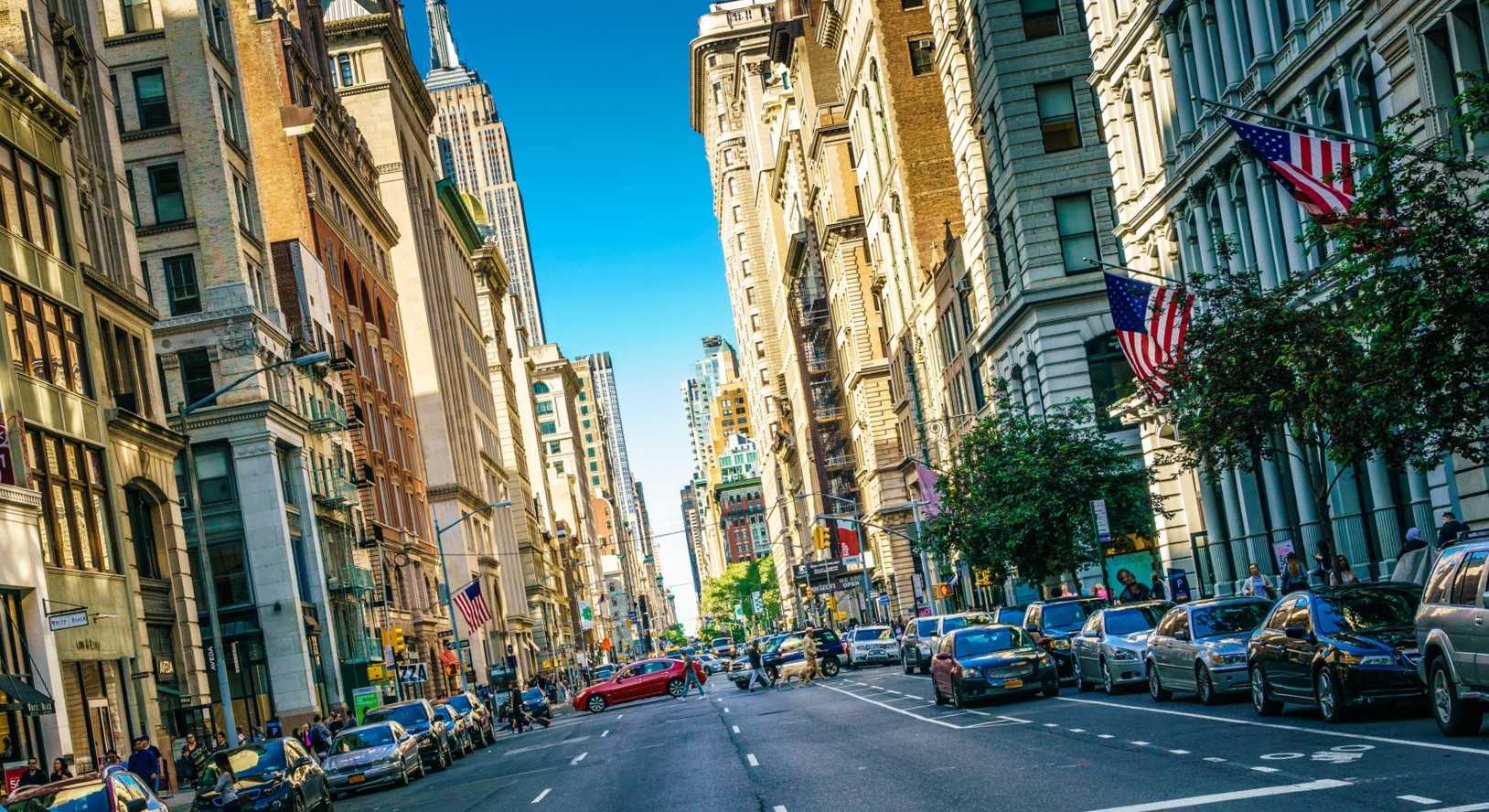
Fifth Avenue in the USA is one of the most famous and prestigious streets in the world, located in the heart of Manhattan, New York City. This iconic avenue runs north-south through the borough and is renowned for its luxury shopping, historic landmarks, and cultural institutions. Here are some key highlights of Fifth Avenue:
Shopping and Luxury
Fifth Avenue is synonymous with high-end retail. It features flagship stores of some of the world's most prestigious brands such as:
Tiffany & Co.: Known for its exquisite jewelry and the iconic Tiffany Blue Box.
Apple Store: The flagship store, with its distinctive glass cube entrance, is a modern architectural landmark.
Bergdorf Goodman: A high-end department store known for its exclusive fashion and impeccable service.
Saks Fifth Avenue: A luxury department store offering designer fashion, accessories, and beauty products.
Events and Parades
Easter Parade and Bonnet Festival: A festive celebration where participants showcase elaborate and creative Easter bonnets.
Macy's Thanksgiving Day Parade: A beloved annual tradition featuring giant balloons, floats, and performances.
St. Patrick's Day Parade: The largest and oldest St. Patrick's Day Parade in the world.
Empire State Building
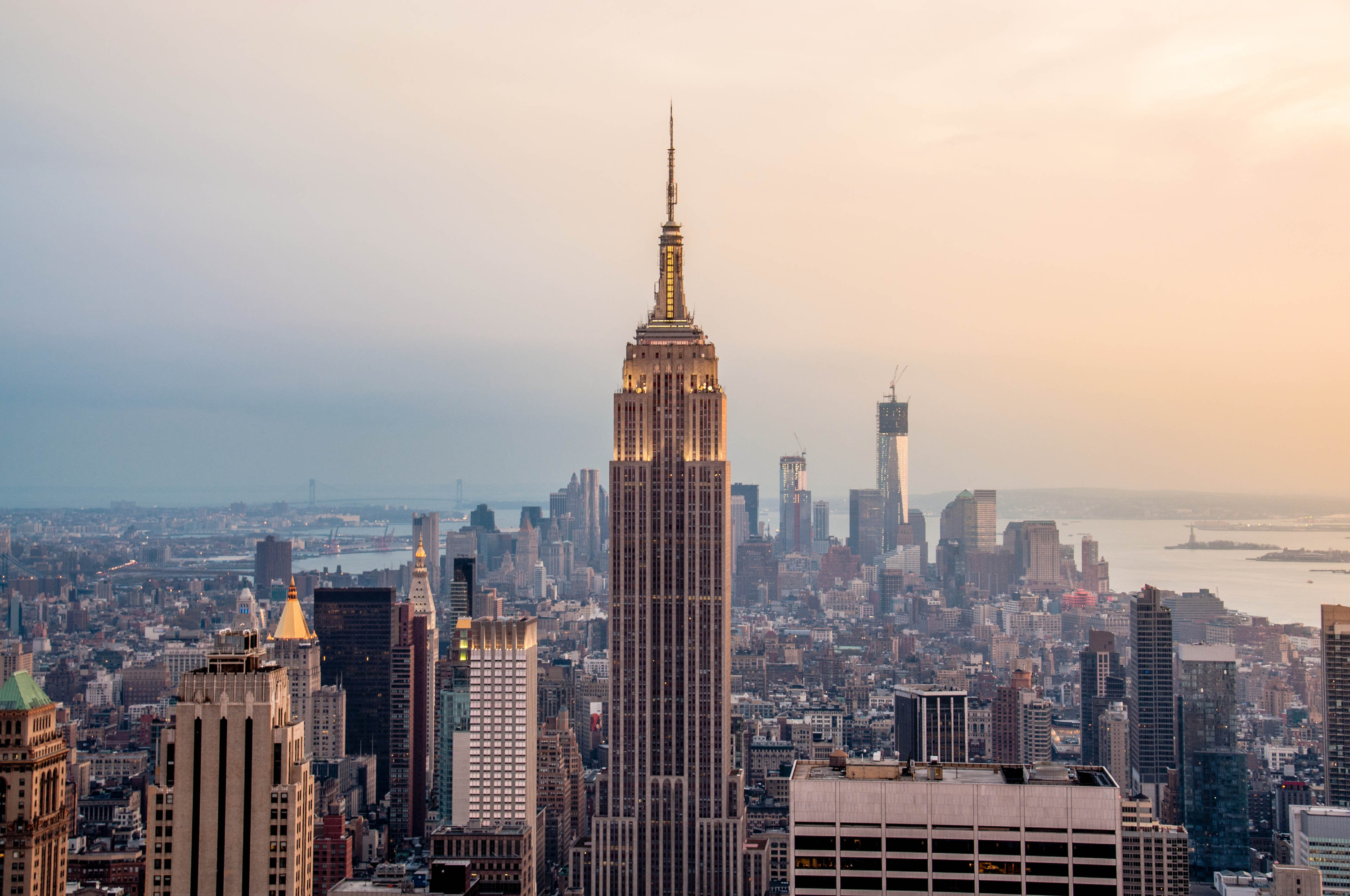
The Empire State Building is a symbol of New York City and the building boom of the rich 1920s. It was built as a speculative office building by the Empire State Company, led by former General Motors executive John J. Raskob and former Governor Al Smith.
The building was constructed at an average rate of four and a half floors per week, taking only thirteen and a half months to complete. Many workers were Irish and Italian immigrants, along with a significant number of Mohawk ironworkers from the Kahnawake reserve near Montreal.
The building’s large antenna was initially designed to be a docking station for dirigibles, with the observation deck intended for passengers. Although this function was never used, the observation deck helped make the Empire State Building one of the most famous and visited buildings in the world. The antenna also made it the tallest building in the world from 1931 to 1972. President Herbert Hoover officially opened the Empire State Building to the public on May 1, 1931, by remotely pressing a button in Washington, D.C., that illuminated the building’s iconic lights.
Both the exterior and the ground floor interior are designated New York City Landmarks, and it was named a National Historic Landmark in 1986.
Central Park
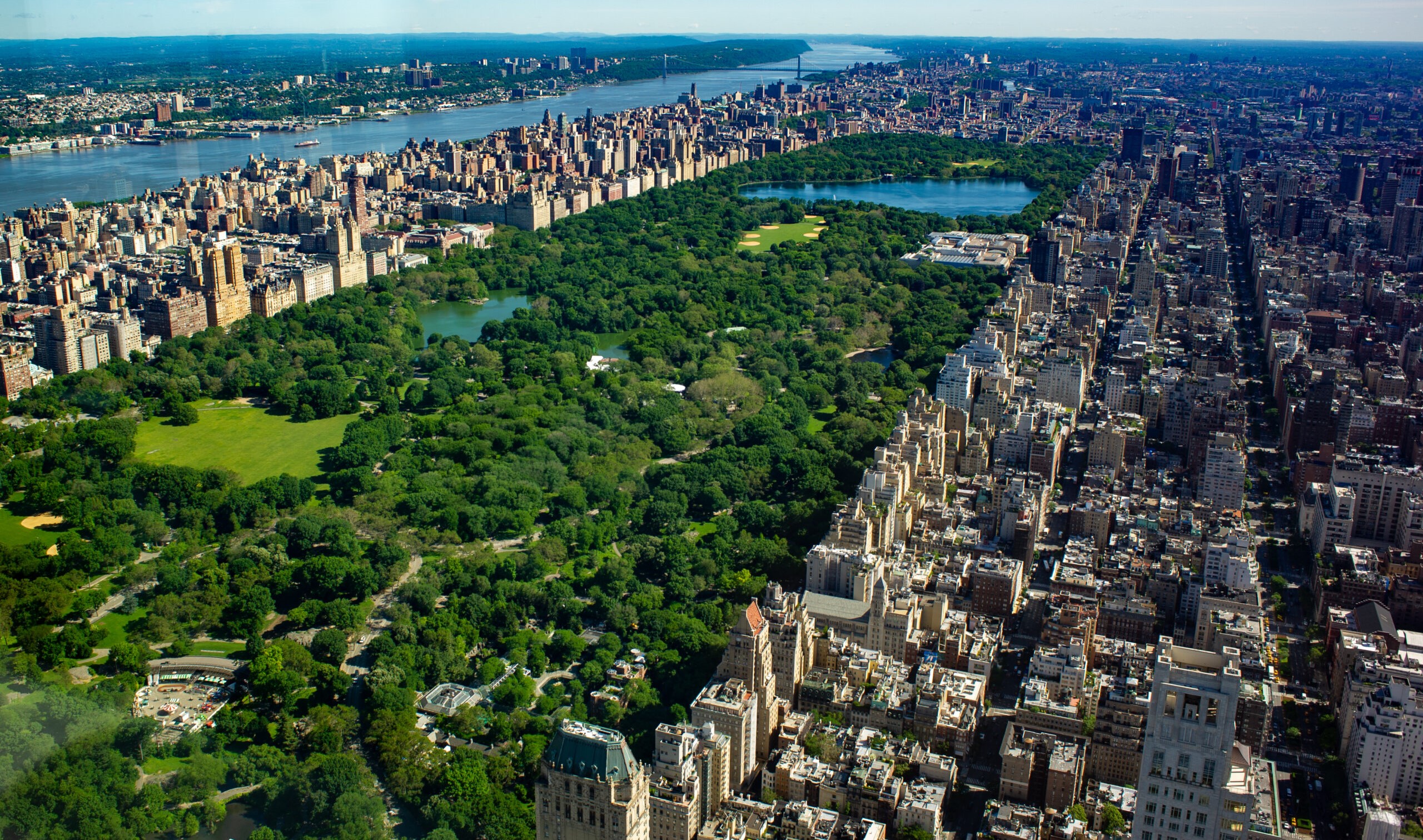
Central Park is a renowned urban park located in the heart of Manhattan, New York City, USA. Spanning 843 acres (about 341 hectares), it stands as one of the most iconic and visited parks globally. Designed by landscape architects Frederick Law Olmsted and Calvert Vaux, Central Park offers a picturesque escape from the bustling city with its lush greenery, serene lakes, winding pathways, and diverse recreational facilities.
Established in 1858, Central Park is not just a recreational oasis but also a cultural hub hosting numerous events, concerts, and festivals throughout the year. It features attractions like Bethesda Terrace and Fountain, the Central Park Zoo, the Conservatory Garden, and the iconic Bow Bridge. The park's beauty and accessibility make it a favorite destination for both locals and tourists, offering a peaceful retreat amidst the vibrant energy of New York City.
Bryant Park

Situated between Fifth and Sixth Avenues and 40th and 42nd Streets, Bryant Park is centrally located near Times Square, the New York Public Library, and Grand Central Terminal. Its accessibility via public transportation makes it a popular destination for both locals and tourists.
Originally established in the 19th century as a public space, Bryant Park has undergone several transformations over the years. It was redesigned in the 1980s to address urban decay and revitalized again in the early 2000s to enhance its appeal and functionality.
The park features lush greenery, manicured lawns, and seasonal flower displays. It provides a peaceful retreat from the bustling city streets, offering visitors a place to relax, read, or enjoy a picnic.
The park is surrounded by notable architectural landmarks, including the New York Public Library's Stephen A. Schwarzman Building on its eastern side, adding to its historic and aesthetic appeal.
Overall, Bryant Park is cherished for its blend of natural beauty, cultural vibrancy, and historical significance, making it a must-visit destination in New York City for residents and tourists alike.
Rockefeller Center
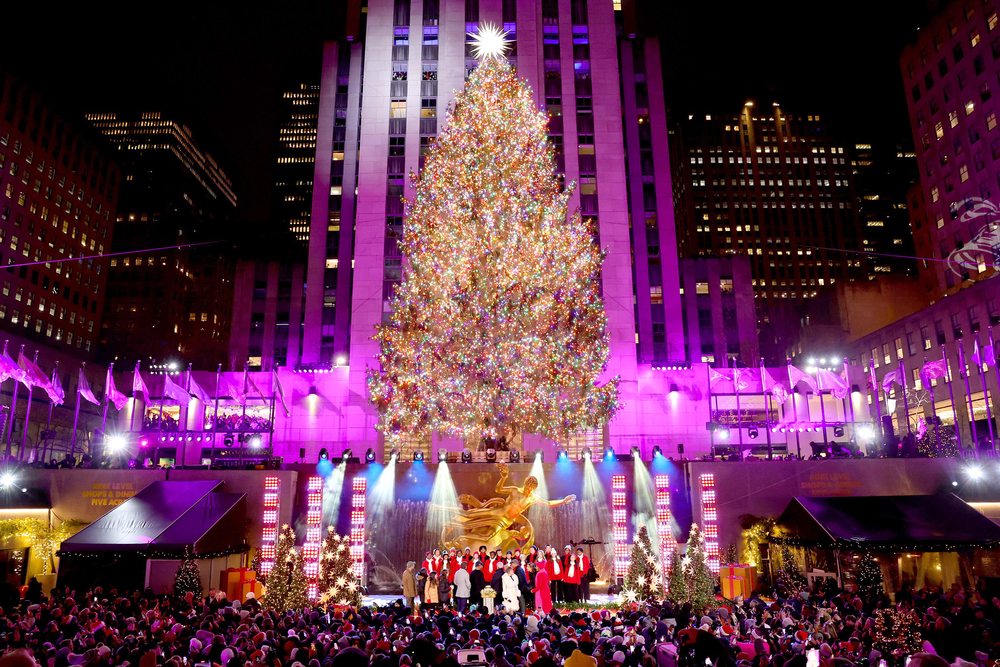
Rockefeller Center, located in the heart of Manhattan, New York City, is a renowned complex of commercial buildings and attractions. It was developed by John D. Rockefeller Jr. in the 1930s and is famous for its Art Deco architecture and cultural significance.
Architecture and Design: The architecture of Rockefeller Center is primarily Art Deco, reflecting the style popular during its construction in the 1930s. The center consists of 19 commercial buildings covering 22 acres (89,000 m²) between 48th and 51st Streets in New York City. The most iconic building in the complex is the 70-story RCA Building (now known as the GE Building), crowned with the prominent Art Deco sculpture of Atlas holding the heavens. The Radio City Music Hall, a famous entertainment venue known for its lavish interiors and performances, is also a notable part of Rockefeller Center.
Cultural and Tourist Attractions:Rockefeller Center is not just a commercial hub but also a cultural landmark. It houses NBC Studios, where popular television shows like "Saturday Night Live" and "The Tonight Show Starring Jimmy Fallon" are produced. The annual Christmas tree lighting ceremony at Rockefeller Center is a globally recognized event, attracting millions of tourists and locals alike during the holiday season. The surrounding area includes the famous ice-skating rink, which transforms into a popular dining venue in the summer.
Rockefeller Center remains a vital part of New York City's skyline and cultural fabric. Its blend of historic architecture, commercial spaces, and iconic attractions continues to make it a must-visit destination for tourists and a significant center of business and entertainment in Manhattan.
Metropolitan Museum Of Art
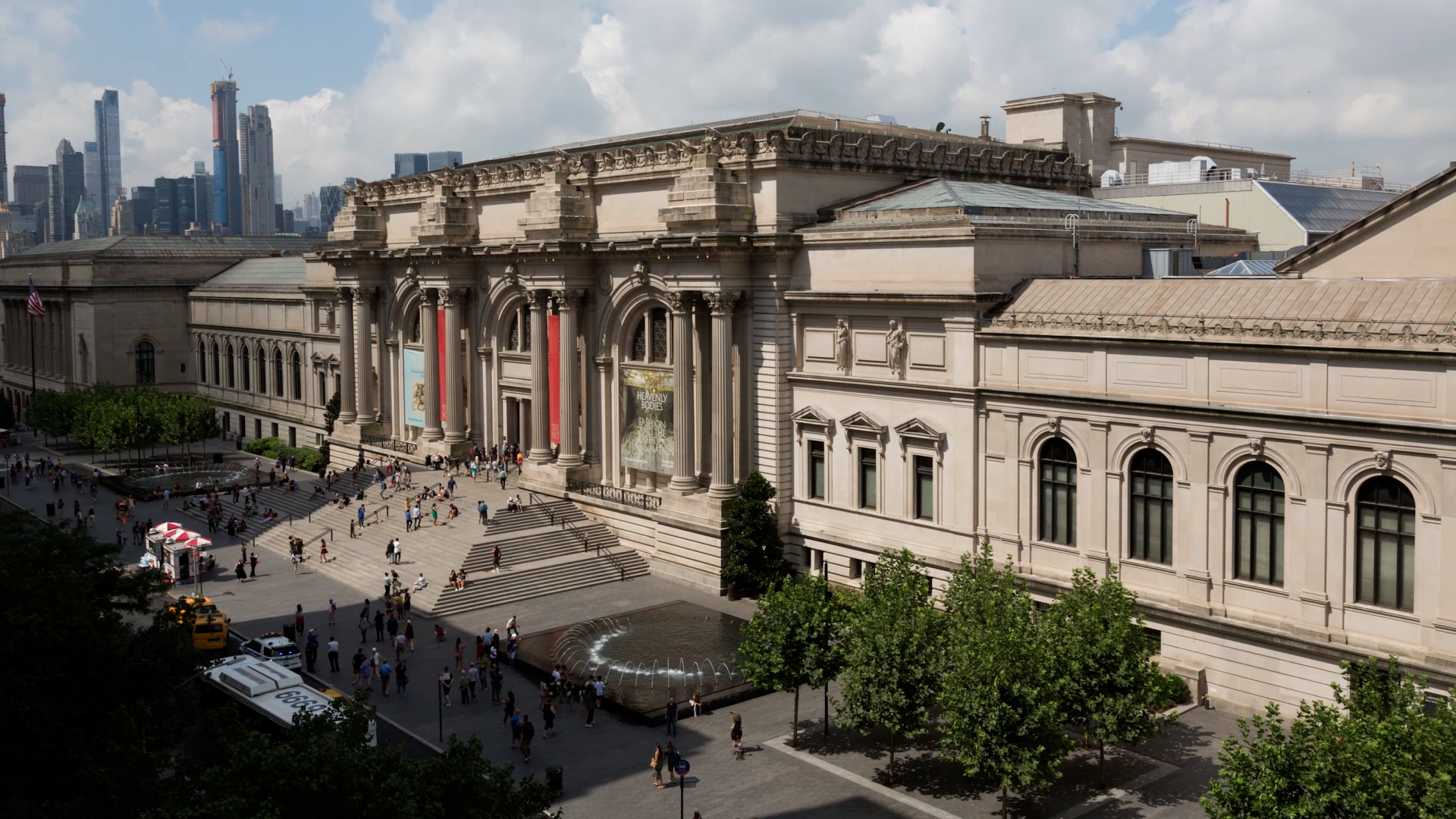
The Metropolitan Museum of Art, located in New York City, is one of the largest and most prestigious art museums in the world. Founded in 1870, it houses an extensive collection spanning over 5,000 years of art from various cultures and time periods. The museum's permanent collection includes artworks from classical antiquity, European paintings, American art, Egyptian artifacts, Asian art, Islamic art, and much more.
The Met, as it's commonly known, is housed in three iconic sites along Fifth Avenue in Manhattan: The Met Fifth Avenue, The Met Breuer (dedicated to modern and contemporary art), and The Met Cloisters (devoted to the art and architecture of medieval Europe). Each location offers a unique experience and showcases different aspects of the museum's vast collection.
Beyond its permanent collection, The Met hosts special exhibitions, educational programs, and events throughout the year. It's a cultural hub that attracts millions of visitors annually, offering a glimpse into the rich tapestry of human creativity and history.
The Museum Of Modern Art
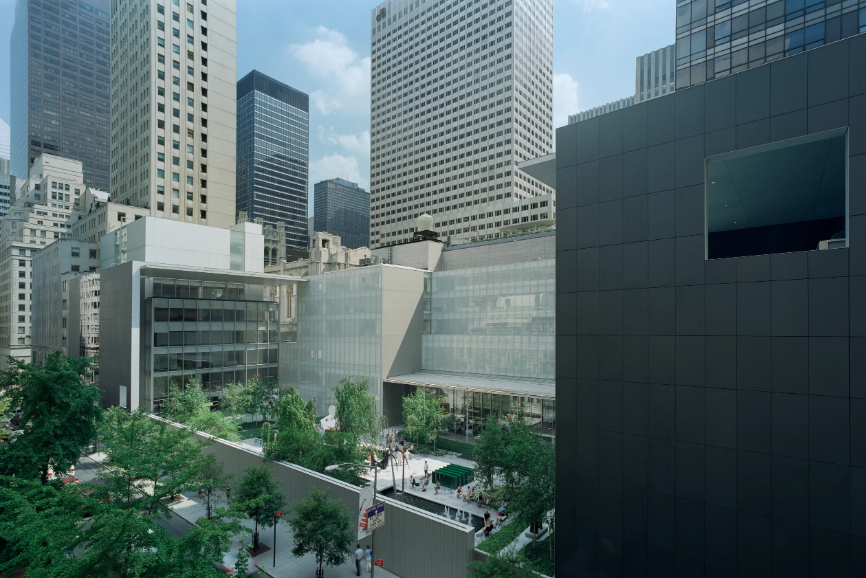
The Museum of Modern Art (MoMA), located in New York City, USA, is one of the world's foremost museums dedicated to modern and contemporary art. Founded in 1929, MoMA's collection includes an extensive range of artworks, including paintings, sculptures, drawings, prints, photography, film, design, and architecture.
MoMA is renowned for its collection of masterpieces by artists such as Vincent van Gogh, Pablo Picasso, Andy Warhol, Frida Kahlo, and many others who have shaped modern art movements. The museum's collection spans iconic works like van Gogh's "Starry Night," Picasso's "Les Demoiselles d'Avignon," and Warhol's "Campbell's Soup Cans."
In addition to its permanent collection, MoMA hosts temporary exhibitions that explore various themes and artists, offering visitors a dynamic experience of contemporary art trends and historical retrospectives. The museum also houses a vast library and archives that support research and scholarship in the field of modern art.
MoMA's architecture itself is noteworthy, with its current building in Midtown Manhattan redesigned and expanded over the years to accommodate its growing collection and visitor numbers. It includes spaces for exhibitions, educational programs, film screenings, and a sculpture garden that provides a tranquil oasis in the heart of bustling Manhattan.
Visitors to MoMA can expect a rich cultural experience, whether exploring the permanent collection, attending special exhibitions, participating in educational programs, or simply enjoying the museum's vibrant atmosphere.
World Trade Center

The World Trade Center (WTC) in New York City, USA, was a complex of seven buildings, most notably known for the iconic Twin Towers. Completed in the early 1970s, the Twin Towers, standing at 1 and 2 World Trade Center, were the tallest buildings in the world at the time. They became a symbol of New York's skyline and a hub of global commerce.
Tragically, on September 11, 2001, the Twin Towers were attacked in a coordinated terrorist attack by hijacked airplanes, resulting in their collapse and significant loss of life. This event profoundly impacted not only New York City but also the world, leading to extensive reconstruction efforts and a memorial at the site to honor the victims.
Today, the rebuilt World Trade Center complex includes the One World Trade Center (also known as the Freedom Tower), which stands as the tallest building in the Western Hemisphere. The site also features the 9/11 Memorial and Museum, a poignant tribute to those who perished in the attacks. The World Trade Center continues to serve as a symbol of resilience and strength for New Yorkers and people worldwide.
High Line
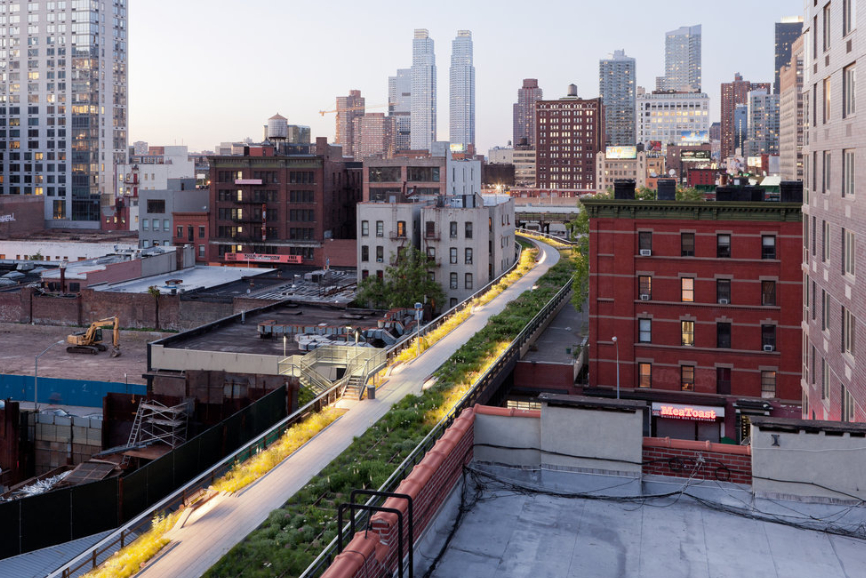
The High Line is a unique and iconic public park located on the west side of Manhattan in New York City. It is built on a 1.45-mile-long stretch of a former elevated freight rail line, which was used to transport goods to and from Manhattan’s industrial district. The park stretches from Gansevoort Street in the Meatpacking District to West 34th Street, near Hudson Yards.
- History and Design: The High Line was initially constructed in the 1930s as part of a major infrastructure project to elevate freight trains above the bustling streets of Manhattan. In the 1980s, the rail line fell out of use and was slated for demolition. However, in 1999, a group of local residents and advocates formed the Friends of the High Line to preserve and repurpose the structure. The park was designed by James Corner Field Operations, with planting design by Piet Oudolf, and architects Diller Scofidio + Renfro. The design incorporates a blend of natural landscaping and urban elements, creating a green oasis amidst the city's architecture.
- Features and Attractions: The High Line offers a variety of experiences, including landscaped gardens, public art installations, and panoramic views of the city and the Hudson River. It features several distinct sections with different themes and styles of planting, seating areas, and pathways. There are also various public art installations and performance spaces integrated into the park's design.
- Cultural Impact: The High Line has become a symbol of urban revitalization and adaptive reuse. Its transformation from an obsolete rail line into a thriving park has inspired similar projects around the world. The park also contributes to the local economy by attracting tourists and enhancing the surrounding neighborhoods.
- Events and Programs: Throughout the year, the High Line hosts a variety of events, including art exhibitions, educational programs, and seasonal activities. It is a popular destination for both locals and visitors, offering a unique perspective on the cityscape and an opportunity for leisurely walks amidst greenery.
- Accessibility and Amenities: The park is accessible from multiple entry points, and there are various amenities, including restrooms and food vendors. The design ensures that it is wheelchair accessible, with elevators and ramps at certain access points.
Brooklyn Bridge
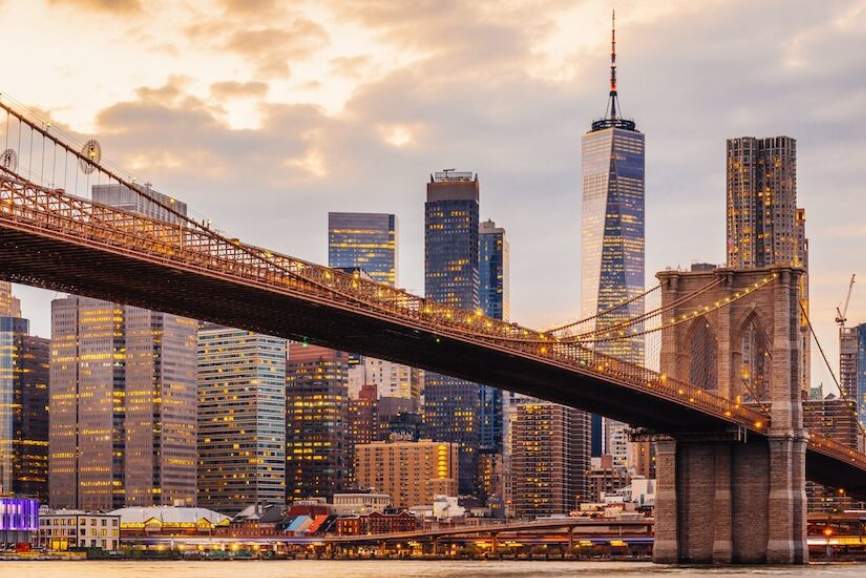
The Brooklyn Bridge, a historic and iconic structure in New York City, spans the East River, connecting the boroughs of Manhattan and Brooklyn. Completed in 1883, it was the first steel-wire suspension bridge ever constructed and remains one of the oldest and most recognizable bridges in the United States.
Design and Engineering
Designed by John A. Roebling, the Brooklyn Bridge showcases innovative engineering for its time. After Roebling's death, his son, Washington Roebling, continued the project. The bridge features two massive stone towers, each standing over 270 feet tall, which support the steel cables that hold up the bridge deck. The design is notable for its Gothic-style arches and the use of steel cables, which was cutting-edge technology in the late 19th century.
Historical Significance
The Brooklyn Bridge was a marvel of engineering and a symbol of progress during the Industrial Revolution. Its completion was celebrated as a major technological and architectural achievement. At the time of its opening, it was the longest suspension bridge in the world, stretching approximately 1,834 feet across the East River. The bridge played a significant role in the development and growth of New York City, facilitating the movement of people and goods between the two boroughs.
Cultural Impact
The Brooklyn Bridge has been featured in numerous films, photographs, and artworks, making it an enduring symbol of New York City. It has also become a popular tourist attraction, offering stunning views of the Manhattan skyline and the East River. The pedestrian walkway on the bridge allows visitors to stroll between Manhattan and Brooklyn, enjoying the scenic vistas and experiencing the bridge's architectural grandeur up close.
Maintenance and Preservation
Over the years, the Brooklyn Bridge has undergone several renovations and maintenance projects to ensure its safety and longevity. These efforts include the repair of the bridge's cables, the reinforcement of its towers, and the upgrade of its infrastructure to accommodate modern traffic needs. Despite these updates, the Brooklyn Bridge retains its historical charm and continues to be a vital transportation link and a beloved landmark.
Wall Street
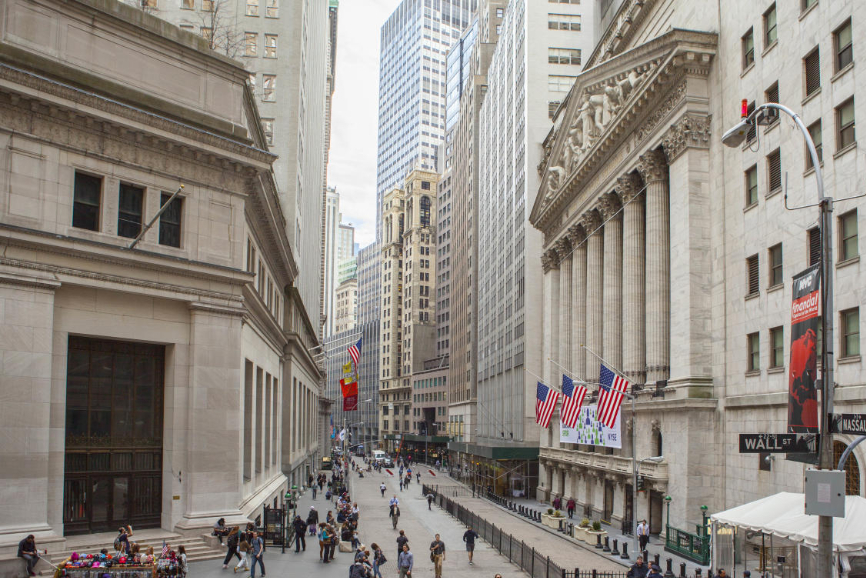
Wall Street, located in the Financial District of Lower Manhattan, New York City, is synonymous with global finance and economic power. It stretches from Broadway to South Street along the East River, and its name derives from the original defensive wall built by Dutch settlers in the 17th century to protect against British and Native American attacks.
Today, Wall Street serves as the epicenter of American finance and houses the New York Stock Exchange (NYSE), the world's largest stock exchange by market capitalization, and the Federal Hall National Memorial, where George Washington took his oath as the first President of the United States. The street is lined with iconic financial institutions, including investment banks, hedge funds, and financial services firms.
Beyond finance, Wall Street is a cultural symbol of capitalism and economic prowess, often portrayed in popular culture and media as a symbol of wealth, ambition, and power. It remains a magnet for tourists and business professionals alike, drawn to its historic landmarks, bustling atmosphere, and the global significance of its financial markets.
New York Public Library
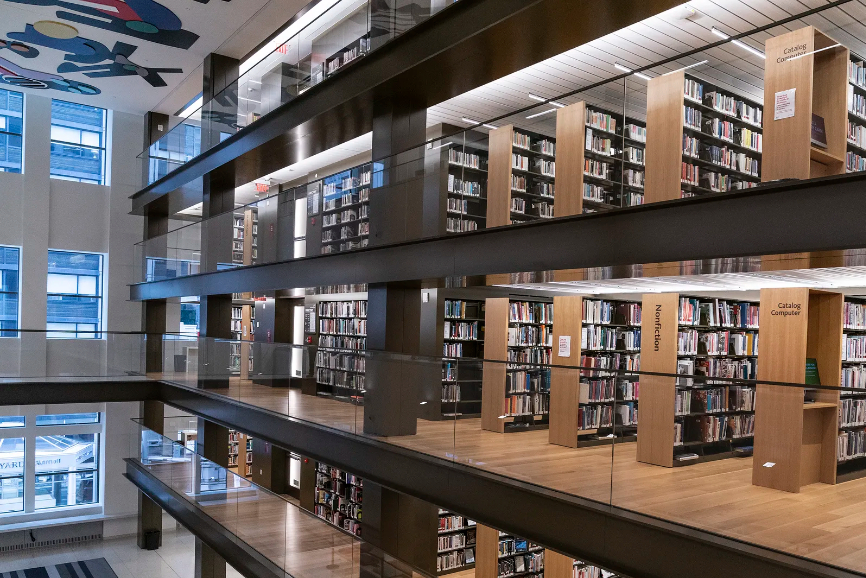
The New York Public Library (NYPL) is one of the largest public library systems in the United States and is a renowned cultural institution located in New York City, USA. It was established in 1895 through the consolidation of two private libraries, and today it consists of four major research libraries and 88 neighborhood branch libraries across Manhattan, the Bronx, and Staten Island.
Main Branch (Stephen A. Schwarzman Building):
- Location: The iconic main branch is located at Fifth Avenue and 42nd Street in Manhattan, adjacent to Bryant Park.
- Architecture: Designed by architects Carrère and Hastings, the building is a Beaux-Arts masterpiece with its majestic marble façade, grand staircases, and iconic lion statues guarding the entrance.
- Collections: It houses extensive research collections in humanities and social sciences, including rare books, manuscripts, maps, and archives.
- Rose Main Reading Room: Famous for its vast space, elegant design, and ceiling murals, it's a quiet haven for studying and research.
- Special Collections: Includes items like the Gutenberg Bible, early editions of Shakespeare, and original manuscripts from famous authors.
Branch Libraries:
- Neighborhood Presence: NYPL serves neighborhoods throughout the boroughs, providing resources, educational programs, and community services.
- Diverse Offerings: Branches cater to various community needs, offering books, digital resources, classes, and cultural programs.
Services and Initiatives:
- Digital Collections: Provides access to e-books, audiobooks, and digital archives.
- Educational Programs: Offers literacy programs, job search assistance, and educational workshops.
- Cultural Events: Hosts author talks, exhibitions, and performances that enrich the cultural life of New York City residents.
Cultural Impact:
- Landmark Status: The main branch is a designated New York City landmark and is listed on the National Register of Historic Places.
- Public Access: Open to the public, providing free access to information and resources for learning and enrichment.
st. patricks cathedral

St. Patrick's Cathedral in New York City is a renowned Roman Catholic cathedral located on Fifth Avenue in Midtown Manhattan. Here are some key points about it:
- Architectural Marvel: Built in the neo-Gothic style, St. Patrick's Cathedral is one of the largest and most impressive Catholic cathedrals in the United States. Its spires rise dramatically above Fifth Avenue, making it a prominent landmark in the city.
- History: Construction of the cathedral began in 1858 and was completed in 1878. It was designed by James Renwick Jr., an influential architect of the 19th century known for his Gothic Revival style.
- Interior: The interior of St. Patrick's Cathedral is breathtaking, featuring intricate stained glass windows, detailed carvings, and a high vaulted ceiling. It is designed to inspire awe and reverence, with a grand nave leading to the altar.
- Religious Significance: As the seat of the Archbishop of the Roman Catholic Archdiocese of New York, St. Patrick's Cathedral holds significant religious ceremonies and masses, attracting both locals and visitors.
- Tourism and Events: Beyond its religious functions, St. Patrick's Cathedral is a popular tourist attraction, welcoming millions of visitors each year. It also hosts concerts, special events, and is a symbol of faith and heritage in New York City.
- Restoration and Preservation: Over the years, the cathedral has undergone several restoration projects to maintain its historic beauty and structural integrity, ensuring it continues to be a symbol of faith and architectural excellence.
© 2024-2025 tourismgaide.com. All rights reserved. Privacy Policy
